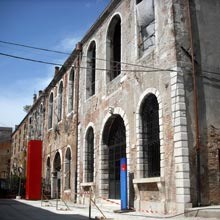Pavilion of the Holy See at the 55th Venice Biennale
In the Beginning
Creation, De-Creation and Re-Creation
Arsenale – Sale d’Armi nord
The Roman Catholic Church will host its first pavilion at the 55th Venice Biennale, featuring the Czech photographer Josef Koudelka, the Milan-based multimedia group Studio Azzurro and the artist Lawrence Carroll. The artists were chosen by a small committee led by Cardinal Gianfranco Ravasi and Micol Forti, the director of contemporary art at the Vatican Museums.
Concept:
‘For this first occasion, we have chosen a theme that is fundamental for culture and for Church tradition. It is also a source of inspiration for many whose works that have left a mark on the history of art: the story told in the Book of Genesis.
‘Specifically, the first eleven chapters have been chosen, as they are dedicated to the mystery of man’s origins, the introduction of evil into history, and our hope and future projects after the devastation symbolically represented by the Flood. Wide-ranging discussions on the multiplicity of the themes offered by this inexhaustible source led to three thematic areas being chosen with which the artists have engaged: Creazione (Creation), De-Creazione (Uncreation), and the New Man or Ri-Creazione (Recreation).
‘The theme of Creation concentrates on the first part of the biblical narrative, when the creative act is introduced through the Word and the breath of the Holy Spirit, generating a temporal and spatial dimension, and all forms of life including human beings.
‘Uncreation, on the other hand, invites us to focus on the choice of going against God’s original plan through forms of ethical and material destruction, such as original sin and the first murder (Cain and Abel), inviting us to reflect on the “inhumanity of man.” The ensuing violence and disharmony trigger a new start for humanity, which begins with the punitive/purifying event of the Flood.
‘In this biblical story, the concept of the voyage, and the themes of seeking and hope, represented by the figure of Noah and his family and then by Abraham and his progeny, eventually lead to the designation of a New Man and a renewed creation, where a profound internal change gives new meaning and vitality to existence.
Card. Gianfranco Ravasi
Rather than requiring the artists to create liturgical art, Cardinal Gianfranco Ravasi said he had asked them to explore the theme of “Creation, De-Creation and Re-Creation” for the 55th edition of the international art exhibition, which opens later this month and includes pavilions from more than 80 countries: “We want to create an atmosphere of dialogue between art and faith.”
As reports the New York Times, for the theme of “Creation,” Studio Azzurro, a collective founded in Milan in 1982, will present an interactive video, “In Principle (and beyond),” which includes images of deaf mutes and women prison inmates who tell their family histories. The collective is known for its large-scale interactive videos, which often break down the wall between viewer and subject. When a visitor steps on an image of a human form, for instance, the form moves in response.
Paolo Rosa, a founder of Studio Azzurro, said the group had been concerned that the Vatican would dictate what they should produce. “But there was no type of interference,” he said.
On the theme of “De-creation,” Josef Koudelka, a photographer with Magnum who is known for his rich black-and-white photographs on the theme of exile and the lingering presence of antiquity, will display 18 large-scale black-and-white photographs.
Lawrence Carroll, who was born in Australia to Irish parents but lives between the United States and Europe, will show five abstract multimedia paintings informed by the post-war Italian movement Arte Povera that engage with the theme of “Re-Creation.”
According to the New York Times, he said that while he was raised Catholic — and his Irish Catholic mother was thrilled at his inclusion in the exhibit — he had had no previous rapport with the Vatican. “They asked no questions about my religious belief.” He said he had been working round the clock in a studio he rented north of Rome to create the paintings that will be shown in Venice.
The Vatican paid some of the expenses for the artists to create the works works, but Lawrence Carroll said he didn’t know who would ultimately own them after the Biennale ended. The Vatican said that the pavilion would cost 750,000 euros ($974,000), all donated by sponsors, including the Italian energy utility ENI.


